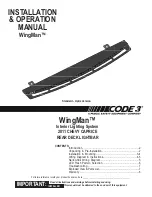
Intelligent technology
187
Controls
Safety
Driving tips
General maintenance
Self-help
Technical data
Switching off
The ESP should normally be left switched on at all times. If required,
you can press the ESP OFF button to switch off the traction control
system (ASR) or the electronic stabilisation program (ESP).
•
Switching off the traction control system (ASR): Press the ESP
button briefly. The traction control system (ASR) can be switched off
in special driving conditions, e.g. if you are driving with snow chains
⇒
page 188. The message ASR off will appear in the display.
•
Switching off the ESP/traction control system (ASR): Press the
ESP button for longer than 3 seconds. The ESP/ASR warning lamp
lights up when the system is switched off, see
⇒
page 16. The
message ESP switched off will appear in the display.
WARNING
•
The ESP is not able to overcome the physical limits of adhesion.
Even with ESP, you should always adjust your speed to suit the
conditions. Please bear this in mind, especially on wet or slippery
road surfaces. Do not let the extra safety provided tempt you into
taking any risks when driving – this can cause accidents.
•
Please note that, when the ESP or ESP/traction control system
(ASR) is switched off, the driven wheels may start to spin, causing
the vehicle to lose grip, in particular on slippery or wet roads -
danger of skidding!
Anti-lock brake system (ABS)
ABS prevents the wheels from locking up under braking.
The anti-lock brake system (ABS) is an important part of the car's
active safety system. However, the ABS will not necessarily guar-
antee shorter stopping distances in all conditions. For instance, on
loose gravel or fresh snow on top of an icy surface (conditions which
anyway require extreme care and reduced speed), the stopping
distance with ABS may even be slightly longer.
How the ABS works
The system runs an automatic self-check when the car reaches a
road speed of about 6 km/h. This may be accompanied by a noise
from the ABS pump.
If one of the wheels is turning too slowly in relation to the road
speed, and is close to locking up, the system will reduce the pres-
sure in the brake line to this wheel. The driver is made aware of this
control process by a pulsating of the brake pedal and accompa-
nying noise. This is a deliberate warning to the driver that one or
more of the wheels is tending to lock up and the ABS control func-
tion has intervened. In this situation it is important to keep the brake
pedal fully depressed so the ABS can regulate the brake application
- do not “pump” the brake pedal.
WARNING
The grip provided by ABS is still subject to the physical limits of
adhesion. Always bear this in mind, especially on wet or slippery
roads. If you notice that the ABS is working (to counteract locked
wheels under braking), you should reduce speed immediately to
suit the road and traffic conditions. Do not let the extra safety
provided tempt you into taking any risks when driving – this can
cause accidents.
Note
If a malfunction should occur in the ABS, this is indicated by a
warning lamp
⇒
page 17.
Brake assist system
The brake assist system helps the driver to achieve
optimum braking effect.
The brake assist system helps to increase braking power and thus to
achieve a shorter stopping distance. If the driver presses the brake
document_0900452a81793dcc.book Seite 187 Mittwoch, 21. März 2007 5:42 17
Summary of Contents for S5 CABRIOLET
Page 1: ...Audi S5 englisch 04 07 Audi S5 Owner s Manual rz 2007 5 42 17 ...
Page 8: ...6 document_0900452a81793dcc book Seite 6 Mittwoch 21 März 2007 5 42 17 ...
Page 9: ...7 Controls document_0900452a81793dcc book Seite 7 Mittwoch 21 März 2007 5 42 17 ...
Page 152: ...150 document_0900452a81793dcc book Seite 150 Mittwoch 21 März 2007 5 42 17 ...
Page 153: ...151 Safety document_0900452a81793dcc book Seite 151 Mittwoch 21 März 2007 5 42 17 ...
Page 186: ...184 document_0900452a81793dcc book Seite 184 Mittwoch 21 März 2007 5 42 17 ...
Page 187: ...185 Driving tips document_0900452a81793dcc book Seite 185 Mittwoch 21 März 2007 5 42 17 ...
Page 210: ...208 document_0900452a81793dcc book Seite 208 Mittwoch 21 März 2007 5 42 17 ...
Page 244: ...242 document_0900452a81793dcc book Seite 242 Mittwoch 21 März 2007 5 42 17 ...
Page 245: ...243 Self help document_0900452a81793dcc book Seite 243 Mittwoch 21 März 2007 5 42 17 ...
Page 278: ...276 document_0900452a81793dcc book Seite 276 Mittwoch 21 März 2007 5 42 17 ...
Page 279: ...277 Technical data document_0900452a81793dcc book Seite 277 Mittwoch 21 März 2007 5 42 17 ...
Page 284: ...282 document_0900452a81793dcc book Seite 282 Mittwoch 21 März 2007 5 42 17 ...
Page 285: ...283 Index document_0900452a81793dcc book Seite 283 Mittwoch 21 März 2007 5 42 17 ...
















































